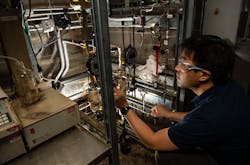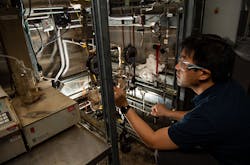Researchers at Washington State University have developed a patented process that turns lignin from agricultural waste into bio-based jet fuel.
The research, published in the journal Fuel, is touted for producing material properties that are critical to jet engine operation, including seal swell, density, efficiency and emissions. The authors noted that the sustainable lignin-based fuel could be mixed with other biofuels. To boot, it could replace petroleum-derived fuels, they said.
The new fuel is experimental, but the results have direct resonance for the aviation industry based on at least two factors—increased energy density and O-ring swelling potential.
Increased energy density. “We found that it not only had increased energy density and content but also could totally replace aromatics, which are a real problem for the aviation industry,” said Bin Yang, professor with WSU’s Department of Biological Systems Engineering and corresponding author on the study. Aromatics are undesirable in jet fuel because they lower the smoke point and cetane, which ignites easily under pressure.
To address environmental concerns, EPA regulations typically limit both the overall volume percent of aromatics. Yet, aromatics continue to be used because alternative solutions are not yet viable. “[Aromatics] provide jet fuel with a density that other sustainable technologies do not,” said Joshua Heyne, co-author, University of Dayton scientist and current co-director of the joint WSU-Pacific Northwest National Laboratory Bioproducts Institute. “Most unique is their ability to swell the O-rings used to seal metal-to-metal joints, and they do this well,” he added.
O-ring-swelling potential. The lignin-based fuel’s properties “offer great opportunities for increasing fuel performance, higher fuel efficiency, reduced emission and lower costs,” noted the authors. The paper, “Lignin-based jet fuel and its blending effect with conventional jet fuel,” discussed how the novel fuel molecules show sealant volume swell that is comparable with aromatics. “While meeting our material needs, these sustainable blends confer higher energy densities and specific energies without using aromatics,” said Heyne.
About the Author

Rehana Begg
Editor-in-Chief, Machine Design
As Machine Design’s content lead, Rehana Begg is tasked with elevating the voice of the design and multi-disciplinary engineer in the face of digital transformation and engineering innovation. Begg has more than 24 years of editorial experience and has spent the past decade in the trenches of industrial manufacturing, focusing on new technologies, manufacturing innovation and business. Her B2B career has taken her from corporate boardrooms to plant floors and underground mining stopes, covering everything from automation & IIoT, robotics, mechanical design and additive manufacturing to plant operations, maintenance, reliability and continuous improvement. Begg holds an MBA, a Master of Journalism degree, and a BA (Hons.) in Political Science. She is committed to lifelong learning and feeds her passion for innovation in publishing, transparent science and clear communication by attending relevant conferences and seminars/workshops.
Follow Rehana Begg via the following social media handles:
X: @rehanabegg
LinkedIn: @rehanabegg and @MachineDesign


